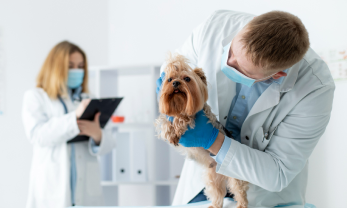(Laparoscopic Ovariectomy)
At Knutsford Vet Surgery, we continually strive to offer the best in pet care. One of the innovative services we provide from our state-of-the-art theatres in Knutsford is keyhole spays, also known as laparoscopic ovariectomy.
One of the most commonly asked questions we get from pet owners is about the timing of the spay procedure. Advice on this topic can vary. As a minimum for dogs, it is advised to wait until 6 months old. Here at Knutsford Vets Surgery we adopt a personalised approach and assess each dog individually. We recommend discussing this with one of our team to decide what’s best for your pet. If opting for a keyhole spay, the timing doesn’t differ significantly from a traditional spay, but the benefits, as outlined in this guide, do make it an appealing option regardless of when you choose to have the procedure done.
A keyhole spay is a minimally invasive procedure that serves as an alternative to the routine spaying method. Through the use of advanced surgical techniques and specialised instruments, this procedure enables us to remove just the ovaries. We use a camera to visualise the ovaries, which aids in the precise removal with minimal discomfort for your pet. The entire procedure leaves your pets with two small incisions, ranging from 0.3-1cm, which are glued together. This eliminates the need for suture removal and contributes to a faster recovery period.
The keyhole spay takes approximately one hour and in the majority of cases, your pet can go home the same day. This is a significant advantage, especially for pet owners who may be anxious about leaving their pets overnight at a veterinary facility.
Our knowledgable team are always happy to answer your queries, no matter how great or small!
Since this is a minimally invasive procedure, it naturally results in less pain post-operation, making the experience far less traumatic for your pet.
Most pets can resume their daily activities within 2-3 days, which is remarkably quicker than traditional spaying methods.
With incisions as small as 0.3 – 1cm, the wounds are much easier to manage, reducing the chances of infection.
Smaller wounds mean that the risk of wound breakdown is significantly lowered, making the post-operative phase much safer.
The minimally invasive nature of the procedure results in less bodily trauma and inflammation, further aiding the recovery process.

A keyhole spay is an excellent choice for pet owners looking for a less invasive and more comfortable spaying option for their pets. With numerous benefits like faster recovery, reduced post-surgery care and lower risks of complications, it stands as a testament to the advancements in veterinary science and our commitment to offering the best for your pets.
For more details or to book an appointment, feel free to contact the Knutsford Vet Surgery team today.


For urgent enquiries the best way to contact us is by phone. Our friendly team are on hand to help!
Knutsford Vets is a family run, independent veterinary surgery in Knutsford. Our amazing caring and highly qualified team of vets, nurses and support staff help us deliver the best healthcare possible to your pets.
© Copyright 2025 – All Rights Reserved